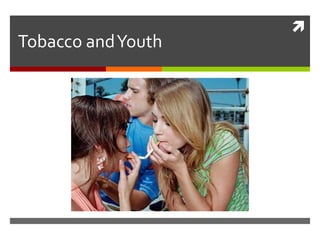
Trends in Youth Smoking and Tobacco Use
- 2. Trends in Youth Smoking
- 3. Trends in Youth Smoking: Gender
- 4. Trends in Youth Smoking: Race/Ethnicity % of High school students who reported current cigarette use, YRBS
- 5. State Specific Rates of Youth Smoking Source: Youth Risk Behavior Survey, 2004.
- 6. More Sobering Statistics 4,000 youth under the age of 18 try smoking for the first time each day 1,000 youth under the age of 18 becomes regular, daily smokers each day 13.6% (2.2%) of high school males (females) use smokeless tobacco 800 million packs of cigarettes are consumed by youth each year ($2.0 billion in sales revenue)
- 7. Why Do We Care about Youth and Tobacco Use? Inability to make accurate assessments of short-run benefits vs. long-term costs Youth who smoke are at greater risk of drinking and/or using illegal drugs Risk of becoming addicted quite high Maximizing life-time exposure to tobacco 90% of new smokers are youth Youth who smoke are less fit and have more lung-related illnesses than their peers who do not smoke
- 8. More Smoking Statistics If smoking rates do not change, 6+ million children alive today will die from a smoking related illness later in their life Taxpayers yearly fed/state burden for smoking-related government health care spending is $630/household/yr
- 9. How do adolescents get their cigarettes?
- 10. Factors that Contribute to Youth Smoking Rates: Advertising Tobacco companies spend 15.4 billion dollars each year on advertising in ways to try to attract adolescent smokers. Why? Promotion of brands Initiation of new smokers Types of advertisements, historically Television (until 1971) Newspapers Magazines (limited by tobacco settlement) Bill Boards (eliminated by tobacco settlement) Transit Point of Sale Product placement in movies Free give-aways (eliminated by tobacco settlement) Sponsorship of sporting events
- 12. What are these ads communicating? Sex How to be “cool” How to be popular How to have fun
- 13. Government Attempts to Reduce the Risk of Youth Smoking? Tobacco settlement Elimination of advertising in youth magazines Selective elimination of advertising in school library editions of Time, Newsweek, People and Sports Illustrated (2005) Anti-smoking advertisements (industry ads may spark curiosity) ID verification for purchasing cigarettes (“carding”) Increasing the sales tax on tobacco products Family Smoking Prevention and Tobacco Control Act of 2009
- 14. Recall, the FDA now has the authority to… Restrict tobacco advertising and promotions (esp. to children) Stop illegal sales of tobacco products to children (internet) Ban candy-flavored cigarettes Require changes in tobacco products such as reducing the nicotine levels Prohibit health claims such as “reduced risk” products Require tobacco companies to disclose the contents of tobacco products Require larger, more informative health warnings Prohibit terms such as “light,” “mild,” or “low tar.”
- 15. Summing up… If we want to bring health care costs and improve American’s health we must tackle tobacco use First and foremost, its use by youth New federal regulations Restrict choice Have the potential to infer considerable benefits if they translate into reduced smoking